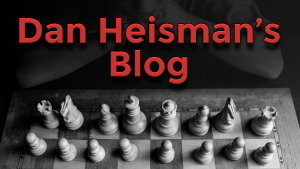Q&A with Coach Heisman Nov 23, 2012
Today's show featured a bit more use of the demonstration board, which usually makes for good TV. One player said that no matter what his opponent did, he always brought out his two knights first, and was this OK? So I set up a board and said "Well, that greatly depends on exactly what is happening. Are you telling me that if your opponent plays...
...and he laughed and wrote "LOL - no!"
But this shows the danger of open-ended questions or ones that are not very specific. Another question difficult to answer in two minutes was "What's the best way to meet flank attacks?" As with many such chess questions, they write entire books (or at least chapters) on these things, so two-minute answers are not going to address the subject very well. I mentioned the well-known "A flank attack is best met by a counter-attack in the center" but then I gave the warning: In Hendriks' book Move First Think Later he makes fun of this particular principle and, in a random survey of flank attacks he easily showed that in many cases meeting a flank attack with a central counterattack was not possible and in many others where it was, a counterattack in the center proved not to be very effective.
This reminds me that a student asked a much more specific, and instructive, question this week about the following position:
What should Black do - and why? This turns out to also be a very Hendriks-type issue. If we try to apply a Silman technique and look for the imbalances and then figure what would logically apply, we might try a reasonable move like 1...Rad8, activating the least active piece and putting an otherwise dormant rook on its best line, an open file. But while this move is reasonable, it does have the drawback of taking away a flight square for the queen when, after 2.Na3, the threat of 3.Nc4 made Black wonder if 1...Rad8 was such a good move after all.
The great thing about this position is that looking at the imbalances will not get you very far, as sometimes happens. Even experience playing similar positions may not clue you in as to what to do. Rolling up your sleeves and analyzing carefully is the only good approach but, in this case, there are some very specific position-dependent factors that make a move good while in a similar position it would be silly.
I gave this position to Houdini 2 and it said that the only move which gives Black an advantage is 1...Nh5! On the surface this seems reasonable: the knight attacks the strong white bishop and opens up lines for black's king bishop. But where's the follow-up? Can't White just play 2.Bh2 or 2.Be3 and the knight on h5 looks silly? That's usually the case, but not here!
On 2.Bh2 Black has the weird 2...Be5!, a maneuver most masters would not consider because it often looks bad upon 3.f4, but here 3.f4?? c4+ wins material. So Black gets rid of White's bishop pair and clears e5 and f4 for knight invasions. If 2.Be3 then 2...Ne5 is now available and Black is doing well, e.g. 3.Bb5 Rad8 (now).
The point is that this type of maneuver is often bad but here, because of unique ideas like 2.Bh2 Be5 3.f4?, it works. There is no rote way to explain to someone how to play this position (i.e., it's more Hendriks than Silman) and, even more, most masters would probably not jump at the correct idea though, given time, they might find it (try it as a puzzle to your local master: show him (her) this position and ask him to find Black's best idea. He may find 1...Nh5, but the idea of 2.Bh2 Be5 will probably take some time, if he finds it at all. If he does, kudos!). Chess, like open-ended questions in a short TV show, is not always that easy.
Two members asked me what was my favorite opening. I really don't have one. I have openings I play at this time or that, but no favorites. I mentioned the Ruy Lopez as being rich in strategic and tactical ideas - I believe I have won more miniature games with the Ruy Lopez in simultaneous exhibitions than I have with all other openings put together. But today I rarely play 1.e4, so I am certainly not just picking what I play  .
.
Someone asked me to tell them all about pawn structure. Talk about straining that 2-3 minute answer! So I replied that this was a giant subject and chess authors write entire books about this, like Kmoch's wonderful (but descriptive notation) Pawn Power in Chess. Then I said I learned more about just about everything from playing lots of games against good players, reviewing games with them, and playing over lots of annotated master games (more like The Most Instructive Games of Chess or The Art of Logical Chess Thinking than Karpov's Best Games. See Annotated Game Collections vs. Instructive Anthologies at http://www.chesscafe.com/text/heisman121.pdf ) - that's pretty much the way I learned most chess subjects X, rather than reading a book just about X.
I think a lot of players have the improvement paradigm: "play a lot of games at 10-20 minutes per side, making moves every 20 seconds or so, then read a book about a subject you want to improve (opening, endgame, positional play), then go out and play more 10-20 minute games and move in 20 seconds or so, but the moves should be better. Keep doing this over time and eventually you become expert and master." This paradigm might work OK for some getting from 800 to 1400/1600 or so (partly because their board vision and tactical vision improves greatly with that much practice), but should get diminishing returns after that. I don't know any experts or masters who did not spend years playing slow games (say 60 minutes or likely more each side) in over-the-board tournaments and chess clubs. As I noted in http://blog.chess.com/danheisman/improving-requires-picking-superior-moves-not-reading-books - the analytical practice of taking time to find better moves has to be extensively practiced itself so you learn how to analyze slowly and carefully, a prerequisite for master status.
Another question was on the bishop pair. I quoted GM Kaufman as saying sometimes it is not so much the bishop pair is so strong as that other pairs (knights or rooks) often get in each other's way but bishops never can. And the bishop pair neutralizes one of the great weaknesses of bishops - the ability to control squares of the opposite color.
No questions today on rules, history, the rating system, or computer chess. Oh well, maybe next time! I did get in a couple of plugs for my Everyman book A Guide to Chess Improvement (the publisher will be happy) and the blog I wrote about it earlier in the day (http://blog.chess.com/danheisman/a-guide-to-chess-improvement-how-the-book-was-made).
Finally someone asked about my Nov 23rd Chess Tip of the Day on Twitter (@danheisman) "The player who uses his rooks best wins the opening". I replied that weaker players often know to use all their pieces but don't routinely do so early in the game ("the main goal of the opening is to effectively, efficiently, and safely activate all the pieces"). But it is difficult to use the rooks effectively without at least getting most of the other pieces out of the way, so believing that the player who best uses his rooks is probably the one with the advantage (barring material loss) is just a good way of reminding them to do that!






